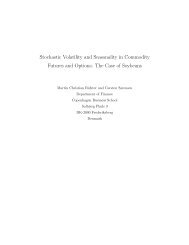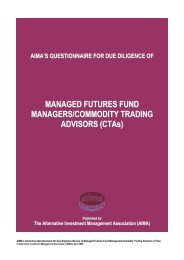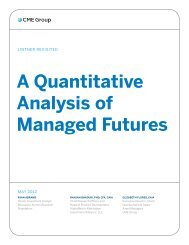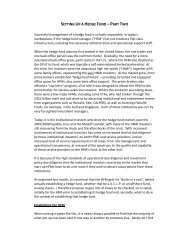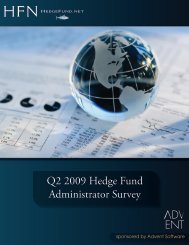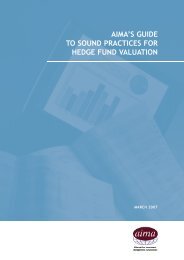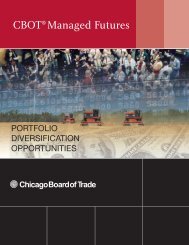Managed Futures - Schindler Trading
Managed Futures - Schindler Trading
Managed Futures - Schindler Trading
Create successful ePaper yourself
Turn your PDF publications into a flip-book with our unique Google optimized e-Paper software.
MANAGED FUTURES<br />
PORTFOLIO DIVERSIFICATION<br />
OPPORTUNITIES
“ Portfolios . . . including judicious investments . . . in leveraged managed futures<br />
accounts show substantially less risk at every possible level of expected return<br />
than portfolios of stocks (or stocks and bonds) alone.”<br />
Dr. John Lintner<br />
Harvard University
What Are<br />
<strong>Managed</strong> <strong>Futures</strong>?<br />
Four Benefits of<br />
<strong>Managed</strong> <strong>Futures</strong><br />
Investment management professionals have been using<br />
managed futures for more than 30 years. More recently,<br />
institutional investors such as corporate and public pension<br />
funds, endowments and trusts, and banks have made<br />
managed futures part of a well-diversified portfolio.<br />
In 2002, it was estimated that over $45 billion was<br />
under management by trading advisors.<br />
The growing use of managed futures by these investors may<br />
be due to increased institutional use of the futures markets.<br />
Portfolio managers have become more familiar with futures<br />
contracts. Additionally, investors want greater diversity in<br />
their portfolios. They seek to increase portfolio exposure<br />
to international investments and nonfinancial sectors, an<br />
objective that is easily accomplished through the use of<br />
global futures markets.<br />
The term managed futures describes an industry made<br />
up of professional money managers known as commodity<br />
trading advisors (CTAs). These trading advisors manage<br />
client assets on a discretionary basis using global futures<br />
markets as an investment medium. <strong>Trading</strong> advisors take<br />
positions based on expected profit potential.<br />
For the purposes of this booklet, managed futures do not<br />
include futures accounts where futures are used in riskmanagement<br />
programs or hedge funds. Those funds may<br />
have as their purpose to dynamically adjust the duration<br />
of a bond portfolio or to hedge the currency exposure of<br />
a foreign equity portfolio.<br />
Table 1: Correlation of Selected Asset Classes 1993-2002*<br />
U.S. Stocks 1 1.00<br />
<strong>Managed</strong><br />
U.S. Stocks Bonds <strong>Futures</strong><br />
Bonds 2 -0.04 1.00<br />
<strong>Managed</strong> <strong>Futures</strong> 3 -0.19 0.33 1.00<br />
Source: Barclay <strong>Trading</strong> Group, Ltd.<br />
*Based on monthly data from 1993-2002 on an annualized basis<br />
1<br />
U.S. Stocks: S&P 500 Total Return Index<br />
2<br />
Bonds: Lehman Brothers Long-Term U.S. Treasury Index<br />
3<br />
<strong>Managed</strong> <strong>Futures</strong>: Barclay CTA Index<br />
<strong>Managed</strong> futures, by their very nature, are a diversified<br />
investment opportunity. <strong>Trading</strong> advisors have the ability to<br />
trade in over 150 different markets worldwide. Many funds<br />
further diversify by using several trading advisors with<br />
different trading approaches.<br />
The benefits of managed futures within a well-balanced<br />
portfolio include:<br />
• opportunity for reduced portfolio volatility risk<br />
• potential for enhanced portfolio returns<br />
• ability to profit in any economic environment<br />
• opportunity to participate easily in global markets<br />
1. Reduced Portfolio Volatility Risk<br />
The primary benefit of adding a managed futures<br />
component to a diversified investment portfolio is that it<br />
may decrease portfolio volatility risk. This risk-reduction<br />
contribution to the portfolio is possible because of the low<br />
to slightly negative correlation of managed futures with<br />
equities and bonds. One of the key tenets of Modern<br />
Portfolio Theory, as developed by the Nobel Prize<br />
economist Dr. Harry M. Markowitz, is that more efficient<br />
investment portfolios can be created by diversifying<br />
among asset categories with low to negative correlations.<br />
Table 1 compares the correlations between managed futures,<br />
bonds, and domestic stocks from January 1993 through<br />
December 2002. As you can see, managed futures are<br />
essentially uncorrelated to the other asset classes.<br />
2. Potential for Enhanced Portfolio Returns<br />
While managed futures can decrease portfolio risk, they can<br />
also simultaneously enhance overall portfolio performance.<br />
For example, chart 1 shows that adding managed futures to<br />
a traditional portfolio improves overall investment quality.<br />
This is substantiated by an extensive bank of academic<br />
research, beginning with the landmark study of Dr. John<br />
Lintner of Harvard University, in which he wrote that “the<br />
combined portfolios of stocks (or stocks and bonds) after<br />
including judicious investments . . . in leveraged managed<br />
futures accounts show substantially less risk at every<br />
1
possible level of expected return than portfolios of stocks<br />
(or stocks and bonds) alone.” 1<br />
Table 2 shows that when viewed as an independent<br />
investment, managed futures have compared favorably<br />
with U.S. stocks and bonds, as well as international stocks,<br />
over the past decade.<br />
In addition, the potential for higher returns using managed<br />
futures compares well with other asset classes in terms of<br />
risk. One way to compare risk is to measure the magnitude<br />
of the worst cumulative loss in value of an investment<br />
from any peak in performance to the subsequent low.<br />
This worst-case, peak-to-valley scenario is called a<br />
drawdown in the futures industry. Chart 2 shows that<br />
managed futures outperformed U.S. and international<br />
stocks during the worst peak-to-valley drawdowns of the<br />
S&P 500, the NASDAQ, and the MSCI Europe, Australia,<br />
and Far East (EAFE) Index.<br />
1<br />
Lintner, John, “The Potential Role of <strong>Managed</strong> Commodity Financial<br />
<strong>Futures</strong> Accounts (and/or Funds) in Portfolios of Stocks and Bonds,”<br />
Annual Conference of Financial Analysts Federation, May 1983.<br />
3. Ability to Profit in Any Economic Environment<br />
<strong>Managed</strong> futures trading advisors can take advantage of<br />
price trends. They can buy futures positions in anticipation<br />
of a rising market or sell futures positions if they anticipate<br />
a falling market. For example, during periods of<br />
hyperinflation, hard commodities such as gold, silver, oil,<br />
grains, and livestock tend to do well, as do the major world<br />
currencies. During deflationary times, futures provide an<br />
opportunity to profit by selling into a declining market with<br />
the expectation of buying, or closing out the position, at a<br />
lower price. <strong>Trading</strong> advisors can even use strategies<br />
employing options on futures contracts that allow for<br />
profit potential in flat or neutral markets.<br />
4. Ease of Global Diversification<br />
The establishment of global futures exchanges and the<br />
accompanying increase in actively traded contract offerings<br />
(see table 3) have allowed trading advisors to diversify their<br />
portfolios by geography as well as by product. For example,<br />
managed futures accounts can participate in at least 150<br />
different markets worldwide, including stock indexes,<br />
financial instruments, agricultural and tropical products,<br />
precious and nonferrous metals, currencies, and energy<br />
products. <strong>Trading</strong> advisors thus have ample opportunity for<br />
profit potential and risk reduction among a broad array of<br />
noncorrelated markets.<br />
Chart 1: Potential Impact of <strong>Managed</strong> <strong>Futures</strong> on the Traditional Portfolio Jan.1980 - May 2003<br />
Annualized Return<br />
13.4%<br />
13.2%<br />
13.0%<br />
12.8%<br />
12.6%<br />
41% Stocks<br />
41% Bonds<br />
18% <strong>Managed</strong> <strong>Futures</strong><br />
45% Stocks<br />
45% Bonds<br />
10% <strong>Managed</strong> <strong>Futures</strong><br />
Traditional Portfolio<br />
50% Stocks<br />
50% Bonds<br />
0% <strong>Managed</strong> <strong>Futures</strong><br />
28% Stocks<br />
28% Bonds<br />
44% <strong>Managed</strong> <strong>Futures</strong><br />
12.4% 9% 9.5% 10% 10.5% 11% 11.5%<br />
Annualized Standard Deviation<br />
Source:<br />
Barclay <strong>Trading</strong> Group, Ltd., <strong>Managed</strong> <strong>Futures</strong>: Barclay CTA Index; Bonds: Lehman Brothers Long-Term Treasury Index; Stocks: S&P 500 Total Return Index<br />
2
Table 2: Performance of Selected Asset Classes 1993-2002*<br />
International <strong>Managed</strong><br />
Year U.S. Stocks 1 Bonds 2 Stocks 3 <strong>Futures</strong> 4<br />
1993 10.1 16.4 24.6 10.4<br />
1994 1.3 –6.9 6.2 –0.6<br />
1995 37.6 30.7 9.4 13.6<br />
1996 22.9 –0.4 4.4 9.1<br />
1997 33.4 14.9 0.2 10.9<br />
1998 28.6 13.5 18.2 7.0<br />
1999 21.0 –8.7 25.3 –1.2<br />
2000 –9.1 20.1 –15.2 7.9<br />
2001 –11.9 4.6 –22.6 0.8<br />
2002 –22.1 17.2 –17.5 12.4<br />
Compound<br />
Return 9.3% 9.5% 2.0% 6.9%<br />
Source: Barclay <strong>Trading</strong> Group, Ltd.<br />
*Based on monthly data from 1993-2002 on an annualized basis<br />
(as percentage of annual return)<br />
1<br />
U.S. Stocks: S&P 500 Total Return Index<br />
2<br />
Bonds: Lehman Brothers Long-Term U.S. Treasury Index<br />
3<br />
International Stocks: Morgan Stanley Capital International<br />
Europe, Australia, and Far East (EAFE) Index<br />
4<br />
<strong>Managed</strong> <strong>Futures</strong>: Barclay CTA Index<br />
Chart 2: Worst Case Declines<br />
And how managed futures performed over the same time period.<br />
30%<br />
20%<br />
10%<br />
0%<br />
-10%<br />
-20%<br />
-30%<br />
-40%<br />
-50%<br />
-60%<br />
-70%<br />
-80%<br />
<strong>Managed</strong> <strong>Futures</strong> 1<br />
<strong>Managed</strong> <strong>Futures</strong> 1<br />
26.3<br />
21.0<br />
23.4<br />
-15.7<br />
-44.7<br />
Source: Barclay <strong>Trading</strong> Group, Ltd.<br />
1<br />
<strong>Managed</strong> <strong>Futures</strong>: Barclay CTA Index.<br />
Greatest drawdown 6-89 through 10-89.<br />
S&P 500 2 -50.7<br />
International<br />
Stocks 4<br />
NASDAQ 3<br />
-75.0<br />
2<br />
S&P 500 Total Return Index. Greatest drawdown 8-00 through 9-02.<br />
3<br />
NASDAQ Composite Index. Greatest drawdown 2-00 through 9-02.<br />
4<br />
International Stocks & Morgan Stanley Capital International<br />
Europe, Australia and Far East (EAFE) Index.<br />
Greatest drawdown 12-99 through 3-03.<br />
Table 3: Most Actively-Traded <strong>Futures</strong> Contracts — Global <strong>Futures</strong> with <strong>Trading</strong> Volume Over 10 Million in 2002<br />
Chicago Board of Trade (CBOT)<br />
Eurex (formerly DTB and SOFFEX)<br />
Chicago Mercantile Exchange (CME)<br />
London International Financial <strong>Futures</strong><br />
and Options Exchange (LIFFE)<br />
Bolsa de Mercadorias & Futuros<br />
(BM&F)<br />
New York Mercantile Exchange (NYMEX)<br />
London Metal Exchange (LME)<br />
Tokyo Commodity Exchange (TOCOM)<br />
US Treasury Bonds<br />
US 10-year Treasury Notes<br />
US 5-year Treasury Notes<br />
Corn<br />
Soybeans<br />
DAX<br />
DJ Euro Stoxx 50<br />
Euro-BUND<br />
Euro-BOBL<br />
Euro-SCHATZ<br />
3-month Eurodollar<br />
S&P 500 Index<br />
E Mini S&P 500<br />
E Mini NASDAQ 100<br />
3-month Euribor<br />
3-month Sterling<br />
FTSE 100 Index<br />
Interbank Deposit<br />
FRA on ID x US Dollar Spread<br />
US Dollar<br />
Crude Oil<br />
Natural Gas<br />
Heating Oil<br />
Unleaded Gasoline<br />
High Grade Primary Aluminum<br />
Copper – Grade A<br />
Platinum<br />
Gold<br />
Kerosene<br />
Gasoline<br />
Commodity Exchange, Japan (CHUBU)<br />
ParisBourse<br />
(formerly MATIF and MONEP)<br />
International Petroleum Exchange (IPE)<br />
Gasoline<br />
Kerosene<br />
CAC 40 10 Euro<br />
Brent Crude Oil<br />
Korea Stock Exchange (KSE) KOSPI 200<br />
OM Stockholm (OM)<br />
Singapore Exchange (SGX, formerly SIMEX)<br />
Sydney <strong>Futures</strong> Exchange (SFE)<br />
Korea <strong>Futures</strong> Exchange (KOFEX)<br />
OMX Index<br />
Eurodollar<br />
3-year Treasury Bonds<br />
3-year Treasury Bonds<br />
3
The Efficiencies of the<br />
<strong>Futures</strong> Markets . . .<br />
. . . Benefit Those Who Use<br />
<strong>Managed</strong> <strong>Futures</strong><br />
Domestic and international corporations, banks, insurance<br />
companies, mutual fund managers, and trading firms use the<br />
futures markets to manage their continuous exposure to price<br />
changes. <strong>Futures</strong> markets make it possible for these hedgers<br />
to transfer that risk exposure to other market participants.<br />
Speculators assume risk in anticipation of making a profit;<br />
in doing so, they add liquidity to the market.<br />
In a market without these risk-takers, hedgers would find it<br />
difficult to agree on a price, because sellers or short hedgers<br />
want the highest possible price while buyers or long hedgers<br />
want the lowest possible price. When speculators enter the<br />
marketplace, the number of ready buyers and sellers<br />
increases, and hedgers are no longer limited by the hedging<br />
needs of others.<br />
In addition to providing liquidity, speculators help to ensure<br />
the stability of the market. For example, by selling futures<br />
when prices are high, speculators decrease demand and help<br />
to lower prices. By purchasing futures when prices are low,<br />
they add to demand and help to raise prices. The volatile<br />
price swings that might otherwise occur are thus tempered<br />
by active trading.<br />
<strong>Managed</strong> futures trading advisors can benefit from the<br />
structural efficiencies of the futures markets.<br />
Liquid markets facilitate entering and exiting market<br />
positions. For example, the average daily trading volume<br />
in the 10-year U.S. Treasury note futures contract is<br />
currently about 600,000 as of mid 2003. With a notional<br />
value of $100,000 per contract, this volume represents<br />
an average daily transfer of about $60 billion. This depth of<br />
liquidity usually allows traders to enter or exit<br />
the Treasury note futures market at the minimum price<br />
change of one tick.<br />
Traders in futures may benefit from transaction costs lower<br />
than those for comparable cash market transactions. For<br />
example, the transaction fee charged for one stock index<br />
contract is substantially less than the transaction fee for<br />
trading an equal dollar amount of stock. Typically, this cost is<br />
1/10 to 1/20 of the comparable cash market execution cost.<br />
Lower market impact costs also benefit the futures<br />
trader. Large-block equity orders sent to the stock exchange<br />
often create a supply-demand imbalance that increases the<br />
bid-ask differential and the cost of the trade. The effect of a<br />
comparable dollar order executed in the futures market is<br />
usually less significant. This is understandable when one<br />
considers the greater liquidity of stock index futures,<br />
where the daily dollar volume is concentrated in a single<br />
standardized contract representing a basket of stocks. In<br />
contrast, the daily dollar volume at a stock exchange<br />
is distributed over many stocks.<br />
The disciplined use of leverage enables traders to<br />
control large dollar amounts in the futures markets<br />
with a comparatively small amount of capital. To ensure<br />
performance of the terms of the futures contract, both the<br />
buyer and seller are required to deposit a performance bond<br />
margin in an account at their brokerage firms. (Note that in<br />
the futures industry, the term margin represents a security<br />
deposit, whereas in the stock market, margin represents a<br />
down payment.) The amount of daily maintenance margin<br />
required by brokerage firms fluctuates with the daily<br />
value of the futures position.<br />
4
Evaluating Risk from an Investor’s Perspective<br />
Investors should understand that there are risks<br />
associated with trading futures and options on futures.<br />
The Commodity <strong>Futures</strong> <strong>Trading</strong> Commission (CFTC)<br />
requires that prospective customers be provided with<br />
risk-disclosure statements which should be carefully<br />
reviewed. Past performance is not necessarily an<br />
indicator of future results.<br />
Potential investors will want to become familiar<br />
with industry definitions for evaluating the risk-return<br />
element of managed futures performance. The following<br />
equations, with some variations, are often used.<br />
Measure of Volatility<br />
Standard Deviation: The dispersion (distance) of<br />
observations (performance data) from the mean (or<br />
average) observation. This measure is often expressed<br />
as a percentage on an annualized basis.<br />
Measure of Capital Loss<br />
Largest Cumulative Decline or Maximum Drawdown:<br />
The largest cumulative percentage (peak-to-valley)<br />
decline in capital of a trading account or portfolio. This<br />
measure of risk identifies the worst-case scenario for a<br />
managed futures investment within a given time period.<br />
Measure of Risk-Adjusted Return<br />
Sharpe Ratio: A ratio that represents a rate of return<br />
adjusted for risk, calculated as follows:<br />
Annual rate of return - Risk-free rate of return<br />
Annualized standard deviation<br />
Chart 3: Volatility of U.S. Equities, Commodities, and Interest Rate Instruments<br />
Monthly Price Volatility, 1992-2003<br />
45<br />
40<br />
35<br />
30<br />
Volatility<br />
25<br />
20<br />
15<br />
10<br />
5<br />
0<br />
Jan-92<br />
Jul-92<br />
Jan-93<br />
Jul-93<br />
Jan-94<br />
Jul-94<br />
Jan-95<br />
Jul-95<br />
Jan-96<br />
Jul-96<br />
Jan-97<br />
Jul-97<br />
Jan-98<br />
Jul-98<br />
Jan-99<br />
Jul-99<br />
Jan-00<br />
Jul-00<br />
Jan-01<br />
Jul-01<br />
Jan-02<br />
Jul-02<br />
Jan-03<br />
Jul-03<br />
Date<br />
U.S. Stocks, Dow Jones Industrial Average SM Commodity Markets, Dow Jones-AIG Commodity Index SM 10-Year Treasury Notes<br />
5
Types of Investment<br />
Opportunities<br />
Participants in the<br />
<strong>Managed</strong> <strong>Futures</strong> Industry<br />
According to <strong>Managed</strong> Account Reports (MAR), in mid-<br />
2003, it was estimated that over $45 billion was under<br />
management by futures trading advisors worldwide.<br />
Currently, there are three primary categories of<br />
managed futures.<br />
Individual Accounts are usually opened by institutional<br />
investors or high net worth individuals. These funds usually<br />
require a substantial capital investment so that the advisor<br />
can diversify trading among a variety of market positions.<br />
An individual account enables institutional investors to<br />
customize accounts to their specifications. For example,<br />
certain markets may be emphasized or excluded. Contract<br />
terms may include specific termination language and<br />
financial management requirements.<br />
Private Pools commingle money from several investors,<br />
usually into a limited partnership. Most of these pools have<br />
minimum investments ranging from approximately $25,000<br />
to $250,000. These futures partnerships usually allow for<br />
admission-redemption on a monthly or quarterly basis. The<br />
main advantage of private pools is the economy of scale that<br />
can be achieved for middle-sized investors. A pool also may<br />
be structured with multiple trading advisors with different<br />
trading approaches, providing the investor with maximum<br />
diversification. Because of lower administrative and<br />
marketing costs, private pools have historically performed<br />
better than public funds.<br />
Public Funds or Pools provide a way for small investors<br />
to participate in an investment vehicle usually reserved<br />
for large investors.<br />
There are several types of industry participants qualified<br />
to assist interested investors. Keep in mind that any of these<br />
participants may, and often do, act in more than one capacity.<br />
Commodity <strong>Trading</strong> Advisors (CTAs) are responsible<br />
for the actual trading of managed accounts. There are over<br />
800 CTAs registered with the National <strong>Futures</strong> Association<br />
(NFA), which is the self-regulatory organization for futures<br />
and options markets. The two major types of advisors are<br />
technical traders and fundamental traders. Technical traders<br />
may use computer software programs to follow pricing<br />
trends and perform quantitative analysis. Fundamental<br />
traders forecast prices by analysis of supply and demand<br />
factors and other market information. Either trading style<br />
can be very successful, and many advisors incorporate<br />
elements of both approaches.<br />
<strong>Futures</strong> Commission Merchants (FCMs) are the<br />
brokerage firms that execute, clear, and carry CTA-directed<br />
trades on the various exchanges. Many of these firms also<br />
act as CPOs and trading managers, providing administrative<br />
reports on investment performance. Additionally, they may<br />
offer customers managed futures funds to help diversify<br />
their portfolios.<br />
Commodity Pool Operators (CPOs) assemble public<br />
funds or private pools. In the United States, these are<br />
usually in the form of limited partnerships. There are<br />
more than 1,500 CPOs registered with the NFA. Most<br />
commodity pool operators hire independent CTAs to<br />
make the daily trading decisions. The CPO may distribute<br />
the product directly or act as a wholesaler to the brokerdealer<br />
community.<br />
Investment Consultants can be a valuable institutional<br />
investor resource for learning about managed futures<br />
alternatives and in helping to implement the managed<br />
fund program. They can assist in selecting the type of<br />
fund program and management team that would be best<br />
6
How the Fee Structure for<br />
<strong>Managed</strong> <strong>Futures</strong> Works<br />
suited for the specific needs of the institution. Some<br />
consultants also monitor day-to-day trading operations<br />
(e.g., margins and daily mark-to-market positions) on<br />
behalf of their institutional clients.<br />
<strong>Trading</strong> Managers are available to assist institutional<br />
investors in selecting CTAs. These managers have<br />
developed sophisticated methods of analyzing CTA<br />
performance records so that they can recommend and<br />
structure a portfolio of trading advisors whose historic<br />
performance records have a low correlation with each other.<br />
These trading managers may develop and market their own<br />
proprietary products or they may administer funds raised by<br />
other entities, such as brokerage firms.<br />
Assessing Performance from<br />
an Investor’s Perspective<br />
There are several indexes that measure managed futures<br />
performance. Investors may wish to review each index to<br />
determine which one provides the most appropriate<br />
performance criteria for their needs.<br />
The following is a list of some of the more familiar indexes:<br />
<strong>Managed</strong> <strong>Futures</strong> Indexes* (Actively <strong>Managed</strong>)<br />
Barclay CTA Index<br />
MAR (<strong>Managed</strong> Account Reports) Indexes<br />
MLM (Mount Lucas Management) Index<br />
Total management fees in the managed futures industry tend<br />
to be higher than those in the equities market. These fees,<br />
however, may be partially offset by the lower commission<br />
costs for comparable dollar transactions in the futures<br />
industry. While management fees do vary by the type of<br />
managed futures account and may be negotiable, there is a<br />
general fee structure. Investors should understand that<br />
performance information for a managed futures account or<br />
fund is almost always expressed net of all such fees.<br />
Typically, the trading advisor or trading manager is<br />
compensated by receiving a flat management fee based<br />
on assets under management in addition to a performance<br />
“incentive” fee based on profits in the account. The<br />
performance fee is almost always calculated net of all<br />
costs to the account, such as management fees and<br />
commissions. The performance fee is thus based on net<br />
trading profits, which are usually paid only if the account<br />
or fund exceeds previously established net asset values.<br />
A few trading managers assume the “netting risk,” whereby<br />
the performance results of all trading advisors in the account<br />
are netted before the investor is charged a performance fee.<br />
The trading manager assumes the netting risk by paying<br />
each CTA according to his or her individual performance.<br />
In addition to management and performance fees, an<br />
account or fund pays transaction costs or brokerage<br />
commissions. These expenses reflect the cost of executing<br />
and clearing futures and generally are calculated on a<br />
per-round-turn basis.<br />
Commodity Market Indexes (Passive)<br />
MLM (Mount Lucas Management) Indexes<br />
Commodity Research Bureau Index (CRB Index)<br />
Goldman Sachs Commodity Index (GSCI)<br />
Dow Jones-AIG Commodity Index SM (DJ-AIGCI SM )<br />
* Contact information on inside of back page.<br />
7
Investor Safety Is Paramount<br />
in the <strong>Futures</strong> Market<br />
Protecting the interests of all participants in the futures<br />
market is the responsibility of exchange and industry<br />
members as well as federal regulators. Working together,<br />
they ensure the financial and market integrity required<br />
by investors.<br />
A brief overview of the Chicago Board of Trade (CBOT ® )<br />
and it’s clearing service provider will illustrate why the<br />
credit risk of exchange-traded products is minimal for<br />
futures investors.<br />
The Market Integrity of the CBOT…<br />
CBOT rules and regulations are designed to support<br />
competitive, efficient, and liquid markets. These rules and<br />
regulations are reviewed continuously by the CBOT and are<br />
periodically amended to reflect the needs of market users.<br />
Making sure that these trading practices and regulations<br />
are followed is the responsibility of the CBOT’s Office of<br />
Investigations and Audits (OIA). The OIA staff works to<br />
prevent trading irregularities and investigate possible<br />
violations of exchange and industry regulations. The<br />
activities of the department include daily on-site<br />
surveillance of trading activity, continuous monitoring<br />
of member firms’ trading practices with state-of-the-art<br />
technology, and prompt, thorough investigations of any<br />
customer complaints.<br />
…Combined with the Financial Integrity of Clearing<br />
Clearing operations are another mechanism used by<br />
exchanges to uphold the integrity of the futures markets.<br />
The clearing service provider (CSP) for the CBOT acts as a<br />
guarantor to clearing member firms for trades it maintains,<br />
reconciles all clearing member firm accounts each day to<br />
ensure that all gains have been credited and all losses have<br />
been collected, and sets and adjusts clearing member firm<br />
margins for changing market conditions.<br />
The CSP settles the account of each member firm at the<br />
end of the trading day, balancing quantities of contracts<br />
bought with those sold. In clearing trades, the CSP<br />
substitutes itself as the opposite party in each transaction,<br />
essentially eliminating counterparty credit risk. It interposes<br />
itself as the buyer to every clearing member seller and the<br />
seller to every clearing member buyer and becomes, in<br />
effect, a party to every clearing member transaction.<br />
Because of this substitution, it is no longer necessary for<br />
the buyer (or seller) to find the original seller (or buyer)<br />
when one wishes to offset a position. The market participant<br />
merely executes an equal and opposite transaction, usually<br />
with an entirely different party, and ends up with a net<br />
zero position.<br />
One of the most important financial safeguards in ensuring<br />
performance on futures contracts is the clearing margin,<br />
which clearing member firms must maintain against their<br />
position in each commodity. These margins are set by the<br />
CSP margin committee and governors. They are<br />
separate from the margins that individual holders of<br />
commodities accounts are required to deposit with<br />
brokers by exchange regulation.<br />
The CSP settles its accounts daily. As closing or settlement<br />
prices change the value of outstanding futures positions, the<br />
CSP collects from those who have lost money as a result of<br />
price changes and credits the funds immediately to the<br />
accounts of those who have gained. Thus, before each<br />
trading day begins, all of the previous day’s losses have<br />
been collected and all gains have been paid or credited. In<br />
this way, the CSP maintains very tight control over margins<br />
as prices fluctuate and ensures that sufficient margin money<br />
is on deposit at all times.<br />
8
For More Information<br />
about the <strong>Futures</strong> Market<br />
The Chicago Board of Trade is dedicated to helping<br />
investors learn more about the benefits of using the<br />
futures market. It thus offers a wide variety of educational<br />
publications and research materials which can be reviewed<br />
and ordered online at www.cbot.com.<br />
For More Information about <strong>Managed</strong> <strong>Futures</strong><br />
Contact the sources listed here for information on CTAs,<br />
commodity pools, how to open a managed account, and<br />
other topics related to managed futures.<br />
© 1996, 1999, 2002, 2003 Board of Trade of the City of Chicago.<br />
All rights reserved.<br />
The information in this publication is taken from sources<br />
believed to be reliable, but it is not guaranteed by the Chicago<br />
Board of Trade as to accuracy or completeness, nor any trading<br />
result, and is intended for purposes of information and education<br />
only. The Rules and Regulations of the Chicago Board of Trade<br />
should be consulted as the authoritative source on all current<br />
contract specifications and regulations.<br />
“Dow Jones SM ,”“The Dow ® ,” “Dow Jones Industrial Average SM ,”<br />
“DJIA SM ” are service marks of Dow Jones & Company, Inc. and have<br />
been licensed for use for certain purposes by the Board of Trade of<br />
the City of Chicago, Inc. (CBOT ® ). The CBOT futures and futures<br />
options contracts based on the Dow Jones SM Averages are not<br />
sponsored, endorsed, sold, or promoted by Dow Jones SM , and<br />
Dow Jones SM makes no representation regarding the advisability<br />
of trading in such contracts.<br />
“Dow Jones SM ,”“AIG ® ,”“Dow Jones-AIG Commodity Index SM ,”<br />
and “DJ-AIGCI SM ” are service marks of Dow Jones & Company, Inc.<br />
and American International Group, Inc., as the case may be, and have<br />
been licensed for use for certain purposes by the CBOT ® . The CBOT<br />
Dow Jones-AIG Commodity Index futures and futures options are<br />
not sponsored, endorsed, or sold by Dow Jones, AIG, American<br />
International Group, or any of their respective subsidiaries or affiliates,<br />
and none of Dow Jones, AIG, American International Group, or any of<br />
their respective subsidiaries or affiliates, makes any representation<br />
regarding the advisability of investing in such products.<br />
Industry Associations<br />
<strong>Managed</strong> Funds Association (MFA)<br />
2025 M Street NW<br />
Washington, DC 20036-3309<br />
202-367-1140 / Fax: 202-367-2140<br />
www.mfainfo.org<br />
<strong>Futures</strong> Industry Association (FIA)<br />
2001 Pennsylvania Avenue NW, Suite 600<br />
Washington, DC 20006-1807<br />
202-466-5460 / Fax: 202-296-3184<br />
www.futuresindustry.org<br />
Reporting Services<br />
Barclay <strong>Trading</strong> Group, Ltd.<br />
508 North 2nd Street, Suite 201<br />
Fairfield, IA 52556<br />
641-472-3456 / Fax: 641-472-9514<br />
www.barclaygrp.com<br />
International Traders Research, Inc.<br />
1020 Prospect Street, Suite 405<br />
LaJolla, CA 92037<br />
858-459-0818 / Fax: 858-459-0819<br />
www.managedfutures.com<br />
<strong>Managed</strong> Account Reports (MAR)<br />
1250 Broadway, 26th Floor<br />
New York, NY 10001<br />
212-213-6202 / Fax: 212-213-1870<br />
www.marhedge.com<br />
Regulatory Agencies<br />
Commodity <strong>Futures</strong> <strong>Trading</strong> Commission (CFTC)<br />
Three Lafayette Centre<br />
1155 21st Street, NW<br />
Washington, DC 20581<br />
202-418-5000 / Fax: 202-418-5521<br />
www.cftc.gov<br />
National <strong>Futures</strong> Association (NFA)<br />
200 West Madison Street, Suite 1600<br />
Chicago, IL 60606-3447<br />
312-781-1300 / Fax: 312-781-1467<br />
http://www.nfa.futures.org<br />
EM35-2R1a 03.04.NA 04-03604
Business Development<br />
141 W. Jackson Blvd.<br />
Chicago, IL 60604-2994<br />
312-341-7955 • fax: 312-341-3027<br />
New York Office<br />
One Exchange Plaza<br />
55 Broadway, Suite 2602<br />
New York, NY 10006<br />
212-943-0102 • fax: 212-943-0109<br />
European Office<br />
St. Michael’s House<br />
1 George Yard<br />
London EC3V 9DH<br />
United Kingdom<br />
44-20-7929-0021 • fax: 44-20-7929-0558<br />
Latin America Contact<br />
52-55-5605-1136 • fax: 52-55-5605-4381<br />
www.cbot.com


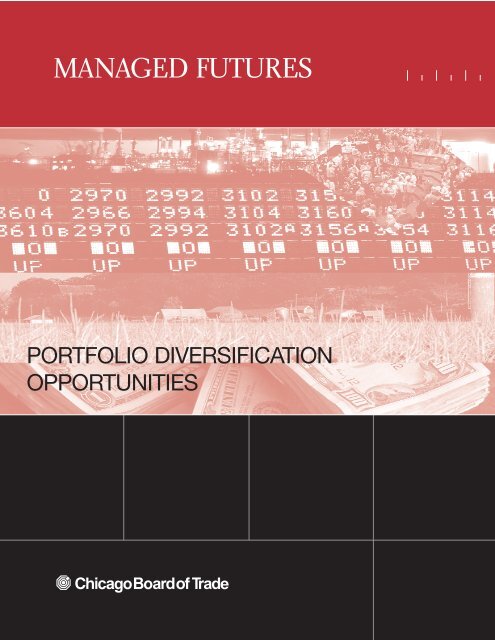
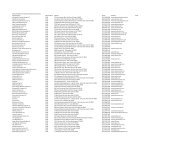
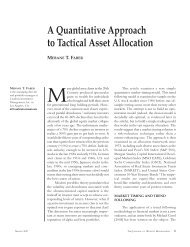
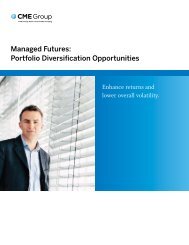
![Definitions & Concepts... [PDF] - Cycles Research Institute](https://img.yumpu.com/26387731/1/190x245/definitions-concepts-pdf-cycles-research-institute.jpg?quality=85)
